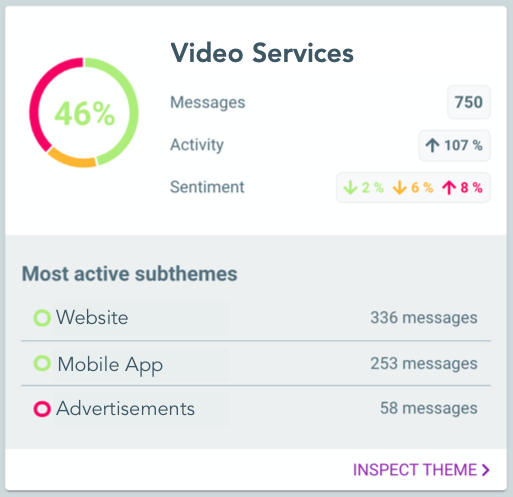NPS open text feedback analysis has been mostly ignored, and the focus has been on the Net Promoter Score alone. NPS is a commonly used metric to evaluate how likely would your user recommend your product or service to someone else. NPS Open text analysis is an addition to the NP Score. NPS is a fast way to receive numeric evaluations from -100 to 100 based on your customers’ ratings. Even though NPS feedback analysis sounds easy, effective, and time-saving, it is problematic in many ways.
For example, the NPS survey’s real eye-opener addition: open text fields. They are time-consuming to analyze since the written feedback must be reviewed manually. Until so far. Read the second part of this blog post, and you’ll see how AI can revolutionize the value of the NPS by automated NPS Open text analysis!
In this blog post, we will first tell you five central problems with NPS. Then we present five ways, how Aiwo’s AI-powered qualitative analytics of NPS open text replies is revolutionizing NPS feedback usability. It’s almost magic, how you can get fully automated reports from open text data. But before getting there, let’s go through the problems that analyzing customer experience with NPS has.
5 central problems with NPS
1. Numbers provide us with limited information about the actual customer experience
You can’t measure customer experience with NPS. A very limited amount of information is provided, if numbers are the main factors to narrate customers’ opinions. Let’s say the customer gives you the likelihood to recommend by the number seven. Seven is a quite neutral number, not the best grade between 0–10 but not the worst either.
Maybe the customer is happy with the customer service! But would expect improvement in the sustainability of the products. That kind of information would be valuable for service and product development, but with NPS the significant info won’t be received.
In other words, numbers won’t tell what in customers’ mind is positive and what is negative.
2. A change in the NPS score doesn’t actually tell us what is changing
Let’s say your company gets the NPS score of 55 this year and last year it was 43. Yay! The score is better than last year, but why? What if the score is 32 this year and last year the NPS was 39.
Do you know the reasons, why the score was lower? Maybe analyzing the open fields will tell you something? But most likely you will have no idea of the full situation picture about the changes in your NPS.
3. We don’t know to which part of the customer experience NPS numbers relate to
Customer experience is the reason why one recommends your service or not. And the experience is a combination of multiple sub-areas. It is important to understand which part of the customer experience is evaluated. Is it the overall experience, a certain incident, or just one visit to your website or with your service?

4. The meaning of numbers isn’t universal for people
Promoters and detractors are terms to describe two different customer types in NPS. Promoters are loyal customers, who already believe in your company’s brand. And then detractors are the opposite ones, who are unsatisfied with your product or service. So, in NPS, the promoters are assumed to score your product between 9–10 and the detractors between 0–6. Then there are the passive customers who will score 7–8.
People perceive numbers in different ways. In many countries, in-build grading systems are completely different. Therefore, numbers are cultural and personal-related, which is why the meaning of the numbers may vary between your customers. For this reason, NPS is not comparable between different countries and cultures.
5. Promoters can leave negative feedback, detractors positive
People who leave a good NPS number score for us can have meaningful criticisms. Therefore, a good NPS score doesn’t tell that there is nothing to develop or any critique from the customers. A good NPS score may leave things unsaid or unclear what needs to be developed.
A good example of this is that when we are looking at open text answers from participants that have given nines and 10’s in NPS, they might have given a negative overall feedback of their experience even though the numeric score was high. We have also found from numerous examples that women tend to give better grades than men. Consequently, demographic information such as gender may affect the result as well.
5 ways how AI is revolutionizing NPS open text feedback analysis
Now you have read five problems of NPS. Next, we are going to tell you how you will get the real benefit out of the NPS with an open question like: “How did you experience our service?“.
Here are the five ways how Aiwo’s AI-based Aiwo CX is revolutionizing NPS analysis:
1. Customer’s narrative is finally seen
Move beyond numbers! Give your customers an opportunity to talk about their experiences with their own voice. This is provided with an open-ended NPS feedback option. That tells us about the actual customer experience. The topics are not chosen by you but based on the customer’s answers.
Aiwo brings up themes based on your customers’ own words. From qualitative and sentiment analysis to quantitative values to understand what is the most common issues they experience. See below one example, how we have brought a theme and its sentiments based on the open text replies (Normally you’ll get from 3-9 main themes in your dashboard):

Assume the zoomed screenshot above is based on your NPS queries open text data. It tells that one of the themes they talk about is the Video Services. Something that 750 people have mentioned during the selected timeframe (e.g. last month). Mostly (46%) with a positive tone, but quite many also with some complaints. The negative tone has increased by 8% during the timeframe (e.g. based on last month). Based on sub-themes ads are pissing them up, but you get generally good feedback from the website and your mobile app. Wouldn’t you want to inspect the theme in more detail?
If you want to really see this very same analysis with your own data, pick a slot here, and we will make it happen!
2. Reasons for the changes are seen
By analyzing your customers’ feedback qualitatively with AI-based service you will get a real-time understanding of what is changing in your customers’ thoughts about your product or service. Changes in the actual themes and subjects that customers are bringing up provide us with information on what is changing.
Aiwo CX SaaS tool gives you the understanding from multiple angles. For instance, based on the change in the message amounts, based on top changes in the sentiment (If one topic is moving heavily to the negative, don’t’ you want to dig deeper on it?) and based on the hidden topics that are suddenly emerging! Trending topics for example are seen in the dashboard as in the example below:

3. Feedback in context
Open feedback always provides us with information about the context of the feedback. Do the customers comment on our company or on single incidents? When all your user’s open text answers are analyzed, you can dig to the most impacted issues and see how the topic is talked over time, and with what other topics are related in customer narrative. Naturally, you can see the customers’ messages on those topics too.
4. Beyond arbitrary scores
As we mentioned earlier, numbers aren’t universal for people and are commonly understood differently. Through open feedback we don’t need to rely on how customers understand the scores they are giving us, we can rely on the things the customer is saying.
That’s why we focus on showing the topics based on your customers’ own wording. Naturally, the numbers will quantify the importance, thus the analysis views are shorted based on that.
5. Understand the problems of your promoters and successes of your detractors
Understanding the negative experiences of our promoters and the positive experiences of our detractors gives us the tools to influence the customer experience in a completely new way and predict and react to possible growing problems among our most devoted customers.
We make it possible by allowing you to see your customers’ tone and topics of the promoters or detractors. Sometimes it’s eye-opening to find that some problems are reported by the users, who gave you 5 and by the ones giving you 9. That makes you focus on the issues customers brought up, not on their scores.
Now you have found out, the five ways how AI could revolutionize the NPS Score, and the new possibilities of how NLP can be utilized with the NPS open text analysis. We at Aiwo are giving dynamic new ways to sky-rocket your business by giving the real-time understanding of your customers by their own voice!
Want to hear more?
Would you like to hear more, how Aiwo is revolutionizing NPS open text analysis? Book a short meeting with us and we will be happy to tell you about our unique service!